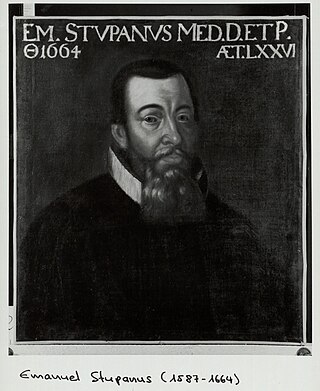
Doué-la-Fontaine is a former commune in the Maine-et-Loire department in western France. On 30 December 2016, it was merged into the new commune Doué-en-Anjou. It is located in the heart of Anjou, a few kilometres from the great châteaux of the Loire Valley.

Capreolus is a genus of deer, the roe deer.
Matteis is an ancient family surname of Italian origin. Most Matteis families now reside in the southern part near Naples in a town called Avellino. The name originated in Chiusano San Domenico, and was often characterized with the nickname "Controme". Chiusano San Domenico is a very small town, but yet very old, going back more than 2000 years. It is mostly a residential community, with many families, including those bearing the name Matteis, including one "Pasquale Matteis". It's a very religious town, yet very nice and peaceful. Near the community is a great mountain which is very important to the people of Chiusano. It has religious significance, and has a cross at its top.
The Helveconae, or Helvaeonae, or Helvecones, or Aelvaeones, or Ailouaiones were a Germanic tribe mentioned by Roman authors. They are possibly connected to the Hilleviones of Naturalis Historia by Pliny the Elder. The Helveconae as such are one of the tribal states of the Lugii mentioned by Tacitus in Germania. The Lugii were located in the Silesia area. Their ethnicity is speculative. Subsequent authors, such as Johann Jacob Hofmann, 1635-1706, identified the people of Tacitus with a people of Ptolemy, the Ailouaiones in Greek, which has been Latinized to Aelvaeones. Perhaps the scholars innovated Helvecones, which is not attested in classical times.
The names used for some major European cities differ in different European and sometimes non-European languages. In some countries where there are two or more languages spoken, such as Belgium or Switzerland, dual forms may be used within the city itself, for example on signage. This is also the case in Ireland, despite a low level of actual usage of the Irish language. In other cases where a regional language is officially recognised, that form of the name may be used in the region, but not nationally. Examples include the Welsh language in Wales in the United Kingdom, and parts of Italy and Spain.

Emmanuel Stupanus was a Swiss physician and professor in Basel.
Petrus Ryff was a Swiss mathematician, physician and chronicler from Basel.
Kidomiyon, also Kirmion and the Keramyon, was one of the four rivers of Ancient Israel.
Pigah was one of the four legendary rivers that encompassed Ancient Israel, the other three of which are Yarden, Kidomiyon and Yarmoch, and which are probably tributaries of the River Jordan.
Volcacius Sedigitus was the titulus of a Roman literary critic who flourished around 100 b.c., noted for his ranking of those he considered the best Latin comics.
Hofmann is a German surname. Notable people with the surname include:
This page is based on this
Wikipedia article Text is available under the
CC BY-SA 4.0 license; additional terms may apply.
Images, videos and audio are available under their respective licenses.



